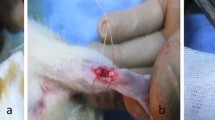Abstract
The purpose of this study was to evaluate Plantago lanceolata (PL) ointment as a topical treatment of collagenase-induced tendonitis in rat, histopathologically. The study was performed on 24 male Wistar rats kept in the same environmental conditions. The animals were randomly assigned to four groups of six rats, and 2.5 units of bacterial collagenase was injected at mid-mass of right and left Achilles complexes. The right legs were considered as treatment and the left ones as control. On treatment legs, 0.1 g PL ointment and on control legs the same amount of eucerin (the vehicle of the ointment) were applied and massaged for 2 min. Each group of animals was euthanized at the end of the first, second, third, and fourth weeks. The Achilles complex of both legs was harvested, processed for hematoxylin and eosin staining, and studied under light microscopy. During the 4 weeks, in the treatment group, significant proliferation of endotendon, earlier disappearance of adipose, inflammatory cells and tendon lobulation, and faster collagen fiber rearrangement were observed.




Similar content being viewed by others
References
Dahlgren LA, van der Meulen MCH, Bertram JEA, Starrak GS, Nixon AJ (2002) Insulin-like growth factor-I improves cellular and molecular aspects of healing in a collagenase-induced model of flexor tendinitis. J Orthop Res 20(5):910–919
Dahlgren LA, Mohammed HO, Nixon AJ (2005) Temporal expression of growth factors and matrix molecules in healing tendon lesions. J Orthop Res 23(1):84–92
Dowling BA, Dart AJ (2005) Mechanical and functional properties of the equine superficial digital flexor tendon. Vet J 170(2):184–192
Dowling B, Dart A, Hodgson D, Smith R (2000) Superficial digital flexor tendonitis in the horse. Equine Vet J 32:369–378
Fons F, Gargadennec A, Gueiffier A, Roussel JL, Andary C (1998) Effects of cinnamic acid on polyphenol production in Plantago lanceolata. Phytochemistry 49(3):697–702
Gibson KT, Burbidge HM, Anderson BH (1997) Tendonitis of the branches of insertion of the superficial digital flexor tendon in horses. Aust Vet J 75(4):253–256
Hosaka Y, Teraoka H, Yamamoto E, Ueda H, Takehana K (2005) Mechanism of cell death in inflamed superficial digital flexor tendon in the horse. J Comp Pathol 132(1):51–58
Maia L, de Souza MV, Ribeiro JI Jr, de Oliveira AC, Alves GES, dos Anjos Benjamin L, Silva YFRS, Zandim BM, Moreira JDCL (2009) Platelet-rich plasma in the treatment of induced tendinopathy in horses: histologic evaluation. J Equine Vet Sci 29(8):618–626
Murai M, Tamayama Y, Nishibe S (1995) Phenylethanoids in the herbs of Plantago lanceolata and inhibitory effect on an arachidonic acid-induced mouse ear edema. Planta Med 6:479–480
Oloumi MM, Vosough D, Derakhshanfar A, Nematollahi MH (2011) The healing potential of Plantago lanceolata ointment on collagenase-induced tendinitis in burros (Equus asinus). J Equine Vet Sci 31(8):470–474
Patterson-Kane JC, Firth EC (2009) The pathobiology of exercise-induced superficial digital flexor tendon injury in Thoroughbred racehorses. Vet J 181(2):79–89
Vigo E, Cepeda A, Gualillo O, Perez-Fernandez R (2005) In-vitro anti-inflammatory activity of Pinus sylvestris and Plantago lanceolata extracts: effect on inducible NOS, COX-1, COX-2 and their products in J774A.1 murine macrophages. J Pharm Pharmacol 57:383–391
Wilson AM, Goodship AE (1991) Mechanical properties of the equine superficial digital flexor tendon (SDFT). J Biomech 24(6):474
Yamamoto E, Hata D, Kobayashi A, Ueda H, Tangkawattana P, Oikawa M, Takehana K (2002) Effect of beta-aminopropionitrile and hyaluronic acid on repair of collagenase-induced injury of the rabbit Achilles tendon. J Comp Pathol 126(2–3):161–170
Acknowledgments
The authors would like to thank Mr. S. Hasanzadeh for preparation of the histopathological slides.
Author information
Authors and Affiliations
Corresponding author
Rights and permissions
About this article
Cite this article
Kakooei, S., Oloumi, M.M., Derakhshanfar, A. et al. A histopathological study of the healing potential of Plantago lanceolata ointment on collagenase-induced tendonitis in rats. Comp Clin Pathol 22, 977–981 (2013). https://doi.org/10.1007/s00580-012-1512-8
Received:
Accepted:
Published:
Issue Date:
DOI: https://doi.org/10.1007/s00580-012-1512-8




